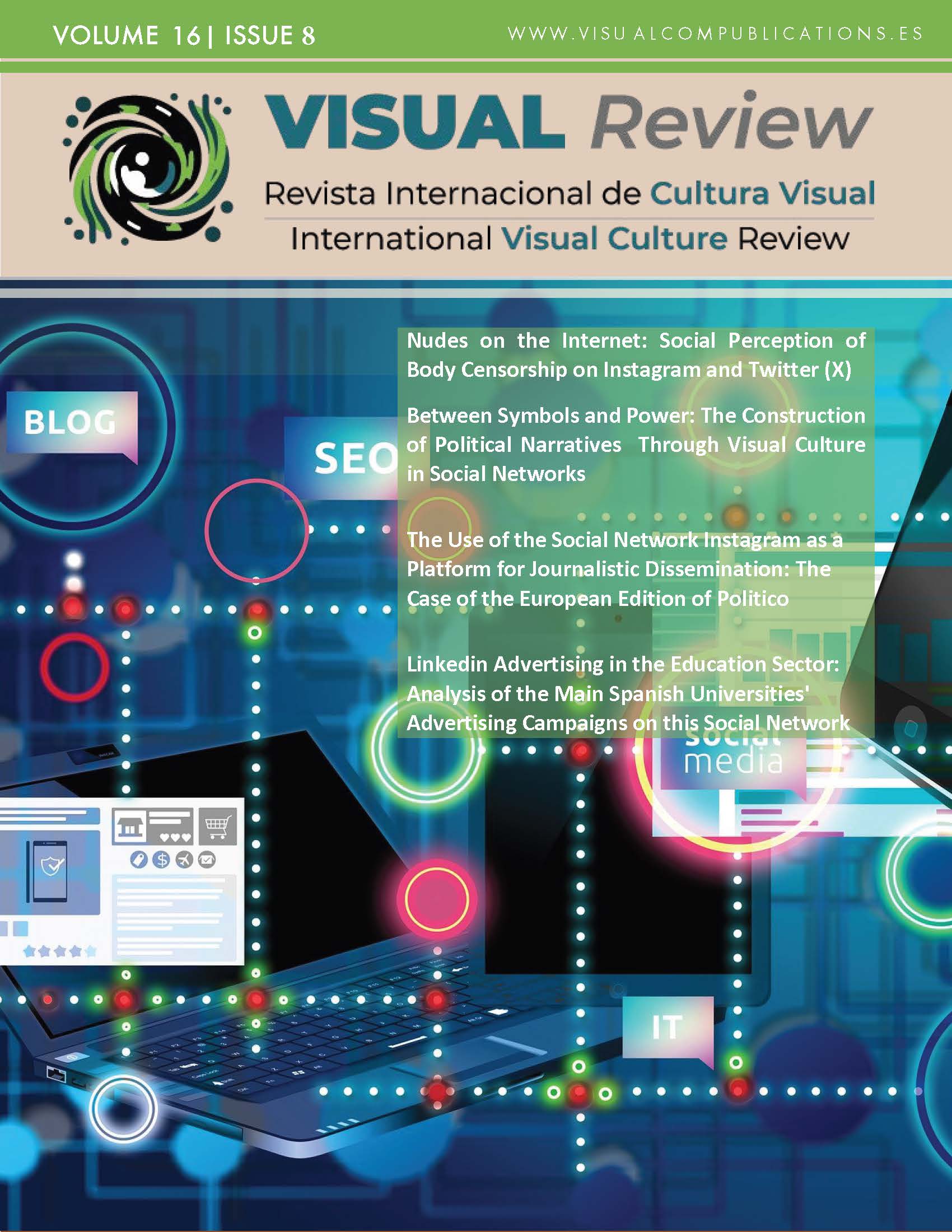TikTok, Zeta Generation and University
An In-Depth Analysis
DOI:
https://doi.org/10.62161/revvisual.v16.5417Keywords:
TikTok, Social Networks, Higher Education, Generation Z, UniversityAbstract
It is beyond dispute that social networks exert a profound influence on contemporary society. The debate surrounding this phenomenon has largely been resolved. The objective of this article is twofold: firstly, to present the evolution of the social network TikTok in the university environment six years after its launch; secondly, to analyse the perception of this social network by university students. The study is based on a review of the profiles created on TikTok by Spanish universities. Furthermore, a survey was conducted to ascertain the perceptions held by students regarding these institutional accounts.
Downloads
Global Statistics ℹ️
|
571
Views
|
711
Downloads
|
|
1282
Total
|
|
References
Abascal, E., & Esteban, I. G. (2005). Análisis de encuestas. Esic editorial.
Ashley, C., & Tuten, T. (2015). Creative strategies in social media marketing: An exploratory study of branded social content and consumer engagement. Psychology & Marketing, 32(1), 15-27. DOI: https://doi.org/10.1002/mar.20761
Ceschan, B. (2020). History of Tik Tok and its Negative Effects on Generation Z. https://brynnceschan.rutgerscamdenenglish.com/history-of-tik-tok-and-its-negative-effects-on-generation-z/
Cortés-Quesada, J. A., Barceló-Ugarte, T., y Fuentes-Cortina, G. (2023). El consumo audiovisual de los Millennials y la Generación Z: preferencia por los contenidos snackables. Doxa Comunicación. omRevista Interdisciplinar De Estudios De Comunicación Y Ciencias Sociales, (36), 303–320. https://doi.org/10.31921/doxacom.n36a1687 DOI: https://doi.org/10.31921/doxacom.n36a1687
Cueto, J. C. (2023). TikTok: cómo es Douyin, la versión de la app en China (y en qué se diferencia de la occidental). BBC News Mundo. https://www.bbc.com/mundo/noticias-65126139
De Vries, L., Gensler, S., & Leeflang, P. S. (2012). Popularity of brand posts on brand fan pages: An investigation of the effects of social media marketing. Journal of Interactive Marketing, 26(2), 83-91. DOI: https://doi.org/10.1016/j.intmar.2012.01.003
Días, C. B., Caro, N. P., & Gauna, E. J. (2015). Cambio en las estrategias de enseñanza-aprendizaje para la nueva Generación Z o de los “nativos digitales”.
https://recursos.educoas.org/sites/default/files/VE14.164.pdf
Duart, J. M. (2009). Internet, redes sociales y educación. RUSC. Universities and Knowledge Society Journal, 6(1) DOI: https://doi.org/10.7238/rusc.v6i1.30
García Galera, M. C.; Abad Alcalá, L. (2019): Los menores en el entorno digital. Usos, influencias, responsabilidades. [Presentación de monográfico]. Doxa Comunicación. Revista Interdisciplinar De Estudios De Comunicación Y Ciencias Sociales, 28, pp. 173-178. DOI: https://doi.org/10.31921/doxacom.n28a09
García, H.V. y Pérez Juste, R. (1989): La investigación del profesor en el aula. Escuela Española.
Heidari, E., Salimi, G., & Mehrvarz, M. (2023). The influence of online social networks and online social capital on constructing a new graduate students’ professional identity. Interactive Learning Environments, 31(1), 214-231. DOI: https://doi.org/10.1080/10494820.2020.1769682
IAB Spain (2023). Estudio de Redes Sociales 2023. https://iabspain.es/estudio/estudio-de-redes-sociales-2023/
Rosa, R. M. (2016). El ADN de la generación Z: entre la economía colaborativa y la economía disruptiva. Revista de estudios de juventud, (114), 29-44.
Ministerio de Universidades (2023). Datos y cifras del Sistema Universitario Español 2022-2023. https://www.universidades.gob.es/wp-content/uploads/2023/04/DyC_2023_web_v2.pdf
Parejo Cuéllar, M., Martín-Pena, D., & Pinto-Zúñiga, R. (2016). El nuevo rol de las universidades en la comunicación científica. Paper presented at the Actas Del I Congreso Internacional Comunicación Y Pensamiento. Comunicracia Y Desarrollo Social (2016), P 523-539.
Prieto, M. (2023). TikTok supera los 18 millones de usuarios en España. Diario Expansión 24 Oct. 2023 (https://www.expansion.com/economia-digital/companias/2023/10/24/65379783468aebf9 068b458d.html) consultado el 2 de marzo de 2024.
Portalés Oliva, M. (2019). Alfabetización mediática y nuevos entornos digitales. Dispositivos móviles, jóvenes y lenguaje audiovisual. Universitat Autònoma de Barcelona. UAB. http://hdl.handle.net/10803/669729
Quiroz, N. T. (2020). TikTok: La aplicación favorita durante el aislamiento. Revista Argentina De Estudios De Juventud, (14), e044. DOI: https://doi.org/10.24215/18524907e044
Rivera-Rogel, D., Yaguache Quichimbo, J., Velásquez Benavides, A. V., & Paladines Galarza, F. (2019). Social networks as a new university venue. Communication: Innovation & Quality, 495-513 DOI: https://doi.org/10.1007/978-3-319-91860-0_30
Rojas, T. A., & Alburqueque, C. C. (2015). La gestión de la reputación digital en las universidades: Twitter como herramienta de la comunicación reputacional en las universidades peruanas. Revista de comunicación, 14(1), 26-47.
Solís, F. M., & Critikián, D. M. (2022). Redes sociales y Generación Z. Doxa Comunicación. Revista Interdisciplinar de Estudios de Comunicación y Ciencias Sociales, 381-399. DOI: https://doi.org/10.31921/doxacom.n36a1707
Statista (2024). Dossier de Statista sobre la red social TikTok. https://es.statista.com/estudio/85663/tiktok/
Valenzuela, R. (2013). Las redes sociales y su aplicación en la educación. Revista Digital Universitaria, 14(4), 1-14.
Viñaras-Abad, M., Llorente-Barroso, C., y Sánchez-Valle, M. (2023). Niños, adolescentes y jóvenes: Tendencias en comunicación y consumo [Presentación del monográfico]. Doxa Comunicación. Revista Interdisciplinar De Estudios De Comunicación Y Ciencias Sociales, (36), 293–301. https://doi.org/10.31921/doxacom.n36a1869 DOI: https://doi.org/10.31921/doxacom.n36a1869
Zhu, C., Xu, X., Zhang, W., Chen, J., & Evans, R. (2020). How health communication via Tik Tok makes a difference: A content analysis of Tik Tok accounts run by Chinese provincial health committees. International Journal of Environmental Research and Public Health, 17(1), 192. https://doi.org/10.3390/ijerph17010192 DOI: https://doi.org/10.3390/ijerph17010192
Downloads
Published
How to Cite
Issue
Section
License
Copyright (c) 2024 VISUAL REVIEW. International Visual Culture Review / Revista Internacional de Cultura Visual

This work is licensed under a Creative Commons Attribution-NoDerivatives 4.0 International License.
Those authors who publish in this journal accept the following terms:
-
Authors retain copyright.
-
Authors transfer to the journal the right of first publication. The journal also owns the publishing rights.
-
All published contents are governed by an Attribution-NoDerivatives 4.0 International License.
Access the informative version and legal text of the license. By virtue of this, third parties are allowed to use what is published as long as they mention the authorship of the work and the first publication in this journal. If you transform the material, you may not distribute the modified work. -
Authors may make other independent and additional contractual arrangements for non-exclusive distribution of the version of the article published in this journal (e.g., inclusion in an institutional repository or publication in a book) as long as they clearly indicate that the work was first published in this journal.
- Authors are allowed and recommended to publish their work on the Internet (for example on institutional and personal websites), following the publication of, and referencing the journal, as this could lead to constructive exchanges and a more extensive and quick circulation of published works (see The Effect of Open Access).













